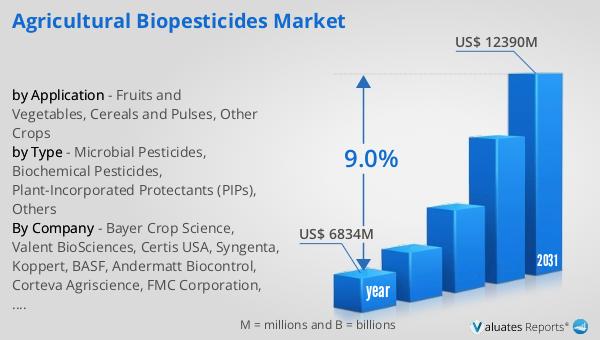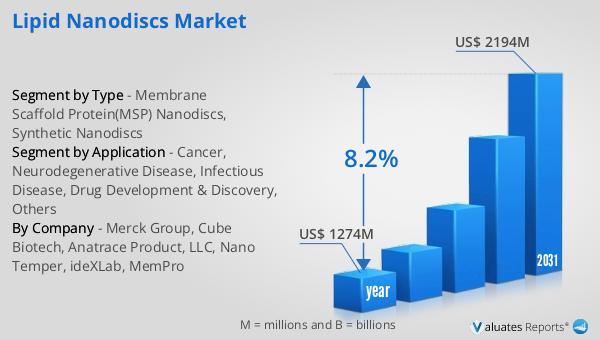What is Global Agricultural Biopesticides Market?
The Global Agricultural Biopesticides Market is a rapidly evolving sector within the agricultural industry, focusing on the development and application of biopesticides derived from natural materials such as animals, plants, bacteria, and certain minerals. Unlike conventional chemical pesticides, biopesticides are considered environmentally friendly and are designed to target specific pests, reducing the risk of harming non-target species, including humans and beneficial insects. This market is driven by the increasing demand for sustainable agricultural practices, as consumers and regulatory bodies push for reduced chemical residues in food products and lower environmental impact. Biopesticides are gaining popularity due to their ability to enhance crop yield and quality while maintaining ecological balance. They are used in various forms, including microbial pesticides, biochemical pesticides, and plant-incorporated protectants (PIPs), each serving distinct roles in pest management. The market's growth is further fueled by advancements in biotechnology and increased research and development efforts aimed at improving the efficacy and cost-effectiveness of biopesticides. As a result, the Global Agricultural Biopesticides Market is poised for significant expansion, offering promising opportunities for innovation and investment in sustainable agriculture.

Microbial Pesticides, Biochemical Pesticides, Plant-Incorporated Protectants (PIPs), Others in the Global Agricultural Biopesticides Market:
Microbial pesticides, biochemical pesticides, plant-incorporated protectants (PIPs), and other categories form the backbone of the Global Agricultural Biopesticides Market, each playing a unique role in pest management. Microbial pesticides are derived from microorganisms such as bacteria, fungi, viruses, or protozoans. These microorganisms target specific pests, often by producing toxins that are harmful to the pests but safe for humans and other non-target organisms. For instance, Bacillus thuringiensis (Bt) is a well-known microbial pesticide that produces proteins toxic to certain insect larvae, making it a popular choice for controlling caterpillar pests in crops like corn and cotton. Biochemical pesticides, on the other hand, include naturally occurring substances that control pests by non-toxic mechanisms. These can include insect pheromones that disrupt mating patterns, plant extracts that deter feeding, or enzymes that interfere with pest development. Biochemical pesticides are valued for their specificity and minimal environmental impact, making them an attractive option for integrated pest management (IPM) programs. Plant-incorporated protectants (PIPs) are another innovative category, involving the genetic modification of plants to produce pesticidal substances within their tissues. This approach allows the plant itself to resist pest attacks, reducing the need for external pesticide applications. For example, Bt crops have been engineered to express the Bt toxin, providing built-in protection against certain insect pests. Other biopesticides include a range of products derived from natural sources, such as minerals or oils, that offer additional pest control options. These diverse categories of biopesticides collectively contribute to the sustainable management of agricultural pests, supporting the global shift towards environmentally friendly farming practices.
Fruits and Vegetables, Cereals and Pulses, Other Crops in the Global Agricultural Biopesticides Market:
The usage of Global Agricultural Biopesticides Market products spans various agricultural sectors, including fruits and vegetables, cereals and pulses, and other crops, each benefiting from the unique advantages offered by biopesticides. In the fruits and vegetables sector, biopesticides are increasingly used to manage a wide range of pests and diseases while minimizing chemical residues on produce. This is particularly important for crops like tomatoes, strawberries, and leafy greens, where consumers demand high-quality, residue-free products. Biopesticides offer targeted pest control, reducing the risk of resistance development and preserving beneficial insect populations, which are crucial for pollination and natural pest regulation. In cereals and pulses, biopesticides play a vital role in managing pests such as aphids, beetles, and fungal pathogens that can significantly impact yield and quality. The use of biopesticides in these crops helps maintain soil health and biodiversity, supporting sustainable farming practices. Additionally, biopesticides are used in other crops, including oilseeds, nuts, and ornamentals, where they provide effective pest control solutions that align with organic and integrated pest management systems. The versatility and safety of biopesticides make them an essential tool for farmers seeking to balance productivity with environmental stewardship. As the demand for sustainable agriculture continues to grow, the application of biopesticides across diverse crop sectors is expected to expand, driving further innovation and adoption in the Global Agricultural Biopesticides Market.
Global Agricultural Biopesticides Market Outlook:
The global market for Agricultural Biopesticides was valued at $6,834 million in 2024 and is anticipated to grow significantly, reaching an estimated size of $12,390 million by 2031. This growth trajectory represents a compound annual growth rate (CAGR) of 9.0% over the forecast period. The increasing valuation of the market underscores the rising demand for biopesticides as a sustainable alternative to traditional chemical pesticides. This shift is driven by growing consumer awareness of the environmental and health impacts of chemical residues in food, as well as regulatory pressures to reduce the use of synthetic pesticides. The projected market expansion reflects the broader trend towards sustainable agriculture, where biopesticides play a crucial role in integrated pest management strategies. As the market evolves, it is expected to offer new opportunities for innovation and investment, particularly in the development of more effective and cost-efficient biopesticide products. The anticipated growth of the Global Agricultural Biopesticides Market highlights the increasing importance of sustainable pest management solutions in modern agriculture, paving the way for a more environmentally friendly and economically viable future for the industry.
| Report Metric | Details |
| Report Name | Agricultural Biopesticides Market |
| Accounted market size in year | US$ 6834 million |
| Forecasted market size in 2031 | US$ 12390 million |
| CAGR | 9.0% |
| Base Year | year |
| Forecasted years | 2025 - 2031 |
| by Type |
|
| by Application |
|
| Production by Region |
|
| Consumption by Region |
|
| By Company | Bayer Crop Science, Valent BioSciences, Certis USA, Syngenta, Koppert, BASF, Andermatt Biocontrol, Corteva Agriscience, FMC Corporation, Isagro, Marrone Bio Innovations, Chengdu New Sun, Som Phytopharma India, Novozymes, Coromandel, SEIPASA, Jiangsu Luye, Jiangxi Xinlong Biological, Bionema |
| Forecast units | USD million in value |
| Report coverage | Revenue and volume forecast, company share, competitive landscape, growth factors and trends |
